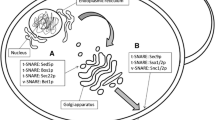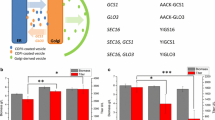Abstract
SNAREs (soluble NSF [N-ethylmaleimide-sensitive factor] attachment receptor proteins) are required at the majority of fusion events during intracellular membrane transport and play crucial roles in facilitating protein trafficking between the various membrane-enclosed organelles and the plasma membrane. We demonstrate increases in the secretion of the Talaromyces emersonii Cel7A (a cellobiohydrolase) and the Saccharomycopsis fibuligera Cel3A (a β-glucosidase), through the separate and simultaneous over-expression of different components of the exocytic SNARE complex in Saccharomyces cerevisiae. Over-expression of SNC1 yielded the biggest improvement in Te-Cel7A secretion (71 %), whilst SSO1 over-expression lead to the highest increases in Sf-Cel3A secretion (43.8 %). Simultaneous over-expression of differential combinations of these SNARE components yielded maximal increases of ~52 % and ~49 % for the secretion of Te-Cel7A and Sf-Cel3A, respectively. These increases generally did not cause deleterious growth effects, whilst differential improvement patterns were observed for the two reporter proteins (Sf-Cel3A and Te-Cel7A). Simultaneous over-expression of up to three of these components, in strains secreting the more efficiently expressed Sf-Cel3A, illustrated a slight decrease in osmotic tolerance at elevated NaCl concentrations, as well as a detectable decrease in ethanol tolerance at increased concentrations. This work illustrates the potential of engineering components of the anterograde secretory pathway, particularly its SNARE components, for the improvement of heterologous cellulase secretion.






Similar content being viewed by others
References
Burri L, Lithgow T (2004) A complete set of SNAREs in yeast. Traffic 5:45–52
Byrne KP, Wolfe KH (2005) The yeast gene order browser: combining curated homology and syntenic context reveals gene fate in polyploid species. Gen Res 15:1456–1461
Çelik E, Çalık P (2012) Production of recombinant proteins by yeast cells. Biotechnol Adv 30:1108–1118
Demain A, Vaishnav P (2009) Production of recombinant proteins by microbes and higher organisms. Biotechnol Adv 27:297–306
Den Haan R, Rose S, Lynd L, Van Zyl WH (2007) Hydrolysis and fermentation of amorphous cellulose by recombinant Saccharomyces cerevisiae. Metab Eng 9:87–94
Den Haan R, Kroukamp H, Van Zyl JHDV, Van Zyl WH (2013) Cellobiohydrolase secretion by yeast: current state and prospects for improvement. Process Biochem 48:1–12
Di Sansebastiano G (2013) Defining new SNARE functions: the i-SNARE. Front Plant Sci 4:99
Galdieri L, Mehrotra S, Yu S, Vancura A (2010) Transcriptional regulation in yeast during diauxic shift and stationary phase. OMICS 14:629–638
Gasser B, Sauer M, Maurer M, Stadlmayr G, Mattanovich D (2007) Transcriptomics-based identification of novel factors enhancing heterologous protein secretion in yeasts. Appl Environ Microbiol 73:6499–6507
Harford N, Cabezon T, Colau B, Delisse AM, Rutgers T, De Wilde M (1987) Construction and characterization of a Saccharomyces cerevisiae strain (RIT4376) expressing hepatitis B surface antigen. Postgrad Med J 63(2):65–70
Hill J, Donald KA, Griffiths DE, Donald G (1991) DMSO-enhanced whole cell yeast transformation. Nucleic Acids Res 19(20):5791
Hoffman CS, Winston F (1987) A ten-minute DNA preparation from yeast efficiently releases autonomous plasmids for transformation of Escherichia coli. Gene 57:267–272
Hou J, Tyo K, Liu Z, Petranovic D, Nielsen J (2012) Engineering of vesicle trafficking improves heterologous protein secretion in Saccharomyces cerevisiae. Metab Eng 14:120–127
Idiris A, Tohda H, Kumagai H, Takegawa K (2010) Engineering of protein secretion in yeast: strategies and impact on protein production. Appl Microbiol Biotechnol 86:403–417
Ilmén M, Den Haan R, Brevnova E, McBride J, Wiswall E, Froehlich A, Koivula A, Voutilainen SP, Siika-aho M, La Grange DC, Thorngren N, Ahlgren S, Mellon M, Deleault K, Rajgarhia V, Van Zyl WH, Pentillä M (2011) High level secretion of cellobiohydrolases by Saccharomyces cerevisiae. Biotechnol Biofuels 4:30
Jahn R, Scheller RH (2006) SNAREs — engines for membrane fusion. Nat Rev Mol Cell Bio 7:631–643
Jäntti J, Aalto M, Oyen M, Sundqvist L, Keränen S, Ronne H (2002) Characterization of temperature-sensitive mutations in the yeast syntaxin 1 homologues Sso1p and Sso2p, and evidence of a distinct function for Sso1p in sporulation. J Cell Sci 115:409–420
Jüschke C, Wächter A, Schwappach B, Seedorf M (2005) SEC18/NSF-independent, protein sorting pathway from the yeast cortical ER to the plasma membrane. J Cell Biol 169(4):613–622
Kloepper TH, Kienle CN, Fasshauer D (2008) SNAREing the basis of multicellularity: consequences of protein family expansion during evolution. Mol Biol Evol 25(9):2055–2068
Krantz M, Ahmadpour D, Ottosson L, Warringer J, Waltermann C, Nordlander B, Klipp E, Blomberg A, Hohmann S, Kitano H (2009) Robustness and fragility in the yeast high osmolarity glycerol (HOG) signal transduction pathway. Mol Syst Biol 5:281
Kroukamp H, Den Haan R, Van Wyk N, Van Zyl WH (2013) Over-expression of native PSE1 and SOD1 in Saccharomyces cerevisiae improved heterologous cellulase secretion. Appl Energy 102:150–156
Laemmli UK (1970) Cleavage of structural proteins during the assembly of the head of bacteriophage T4. Nature 227(5259):680–685
La Grange DC, Pretorius IS, Claeyssens M, Van Zyl WH (2001) Degradation of xylan to d-xylose by recombinant Saccharomyces cerevisiae coexpressing the Aspergillus niger β-xylosidase (xlnD) and the Trichoderma reesei xylanase II (Xyn2) genes. Appl Environ Microbiol 67(12), 5512v5519
Lee FW, Da Silva NA (1997) Sequential delta integration for the regulated insertion of cloned genes in Saccharomyces cerevisiae. Biotechnol Progr 13(4):368–373
Lynd L, Van Zyl W, McBride J, Laser M (2005) Consolidated bioprocessing of cellulosic biomass: an update. Curr Opin Biotechnol 16:577–583
Malsam J, Kreye S, Söllner T (2008) Membrane fusion: SNAREs and regulation. CMLS Cell Mol Life S 65:2814–2832
McBride JE, Zietsman JJ, Van Zyl WH, Lynd LR (2005) Utilization of cellobiose by recombinant β-glucosidase-expressing strains of Saccharomyces cerevisiae: characterization and evaluation of the sufficiency of expression. Enzyme Microb Technol 37:93–101
McBride JEE, Deleault KM, Lynd LR, Pronk JT (2008) Recombinant yeast strains expressing tethered cellulase enzymes. Patent PCT/US2007/085390
Nigam JM, Ireland RS, Margaritus A, Lachance MA (1985) Isolation and screening of yeasts that ferment d-xylose directly to ethanol. Appl Environ Microbiol 50(6):1486–1489
Ostergaard S, Olsson L, Nielsen J (2000) Metabolic engineering of Saccharomyces cerevisiae. Microbiol Mol Biol R 64(1):34–50
Protopopov V, Govindan B, Novick P, Gerst JE (1993) Homologues of the synaptobrevin/VAMP family of synaptic vesicle proteins function on the late secretory pathway in S. cerevisiae. Cell 74(5):855–861
Rader RA (2007) Biopharmaceutical products in the US and European markets, 6th edn. BioPlan Associates, Rockville
Romanos MA, Scorer CA, Clarke JJ (1992) Foreign gene expression in yeast: a review. Yeast 8:423–488
Romanos M (1995) Advances in the use of Pichia pastoris for high-level gene expression. Curr Opin Biotechnol 6:527–533
Ruohonen L, Toikkanen J, Tieaho V, Outola M, Soderlund H, Keranen S (1997) Enhancement of protein secretion in Saccharomyces cerevisiae by overproduction of Sso protein, a late-acting component of the secretory pathway. Yeast 13(4):337–351
Sambrook J, Russel DB (2001) Molecular cloning: a laboratory manual. Cold Spring Harbor Laboratory Press, Cold Spring Harbor
Schmidt FR (2004) Recombinant expression systems in the pharmaceutical industry. Appl Microbiol Biotechnol 65:363–372
Schröder M (2008) Engineering eukaryotic protein factories. Biotechnol Lett 30:187–196
Shen D, Yuan H, Hutagalung A, Verma A, Kümmel D, Wu X, Reinisch K, McNew JA, Novick P (2013) The synaptobrevin homologue Snc2p recruits the exocyst to the secretory vesicle by binding to Sec6p. J Cell Biol 202(3):509–526
Stephen JD, Mabee WE, Saddler JN (2012) Will second-generation ethanol be able to compete with first-generation ethanol? Opportunities for cost reduction. Biofuels Bioprod Bioref 6:159–176
Teste M, Duquenne M, François JM, Parrou J (2009) Validation of reference genes for quantitative expression analysis by real-time RT-PCR in Saccharomyces cerevisiae. BMC Mol Biol 10:99
Van Rensburg E, Den Haan R, Smith J, Van Zyl WH, Görgens JF (2012) The metabolic burden of cellulase expression by recombinant Saccharomyces cerevisiae Y294 in aerobic batch culture. Appl Microbiol Biotechnol 96(1):197–209
Van Rooyen R, Hahn-Hägerdal B, La Grange DC, Van Zyl WH (2005) Construction of cellobiose-growing Saccharomyces cerevisiae strains. J Biotechnol 120:284–295
Weinberger A, Kamena F, Kama R, Spang A, Gerst J (2005) Control of Golgi morphology and function by Sed5 t-SNARE phosphorylation. Mol Biol Cell 16:4918–4930
Xu L, Shen Y, Hou J, Peng B, Tang H, Bao X (2013) Secretory pathway engineering enhances secretion of cellobiohydrolase I from Trichoderma reesei in Saccharomyces cerevisiae. J Biosci Bioeng. doi:10.1016/j.jbiosc.2013.06.017
Yoshikawa K, Tanaka T, Ida Y, Furusawa C, Hirasawa T, Shimizu H (2011) Comprehensive phenotypic analysis of single-gene deletion and overexpression strains of Saccharomyces cerevisiae. Yeast 28:349–361
Acknowledgements
Funding for this project was provided by the National Research Foundation (South Africa).
Conflict of interest
The authors declare that there are no conflicts of interest associated with the submission of this study.
Author information
Authors and Affiliations
Corresponding author
Rights and permissions
About this article
Cite this article
Van Zyl, J.H.D., Den Haan, R. & Van Zyl, W.H. Over-expression of native Saccharomyces cerevisiae exocytic SNARE genes increased heterologous cellulase secretion. Appl Microbiol Biotechnol 98, 5567–5578 (2014). https://doi.org/10.1007/s00253-014-5647-1
Received:
Revised:
Accepted:
Published:
Issue Date:
DOI: https://doi.org/10.1007/s00253-014-5647-1




